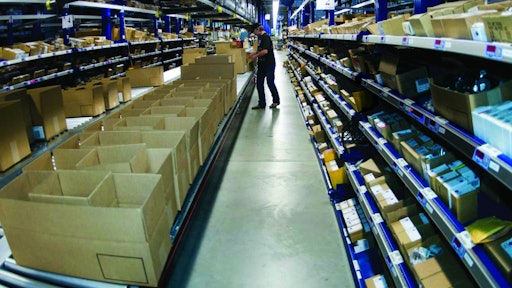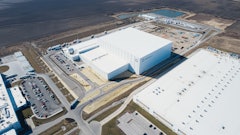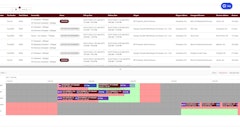
SPECIAL REPORT
Five Automation Myth Busters
Myth # 1: I need a new, automated facility for optimization.
You want to keep up with the latest and greatest technologies and you think that means having to scrap your existing DC to build a new one with all the bells and whistles today’s technologies offer. But building a new facility and then moving your operation and your personnel is not only expensive—it means lost time and lost revenues. SSI Schaefer has a few helpful suggestions so you can bust that myth.
A major grocer wants to automate its DC with an automated case-picking system, reports Keith Berres, executive sales manager for the Charlotte, NC-based company.
“They have several existing buildings, but they are land-locked which means it is not cost-effective for them to tear down one of their buildings to construct a new one. They asked us to design a case-picking system that will fit into one of their 30-foot-high buildings,” says Berres. “We challenged our engineers with the problem and they developed a proposal that will allow the grocer to retrofit one of their existing buildings with the automation they desire. This will enable them to achieve the lower cost per case in handling without having to build a new facility.”
So the grocer can forget about the worry of additional capital investment for a brand-new building. The company can achieve increased throughput by improving its systems while still operating a fully functional distribution center.
Some companies might think they have to have or build an 80-foot-high or 100-foot-high building before they can even consider adding automation, explains Berres. “But the thing to remember is you can implement automation beginning with retrofitting a module at a time within an existing facility while slowly increasing your throughput. This means you can lower your cost per case or per piece by utilizing your existing footprint.”
The possibilities for retrofitting your facility for greater optimization are numerous. “The options run from the top end of the scale with an automated case-picking system—all the way down to a goods-to-man application,” Berres explains. “Batch-pick systems rely on miles and miles of conveyor systems, so think about the possibility of removing some portion of your conveyor and sorter system and replacing it with a product-to-person system that requires a smaller footprint.”
Schaefer offers a storage module that brings the required goods out to the worker, shortening the travel time to pick orders. “This allows the same amount of throughput while requiring fewer people to perform the work,” Berres adds.
By choosing to stay in your existing facility, you might think about removing less-optimized systems and replacing them with more efficient systems. “For instance, you can convert a static rack to a mini-load or another type of automated system,” Berres says.
The savings involved in retrofitting are significant, reports Berres. “The key to any project is to understand the customer’s data relative to their orders and inventory. We evaluate what a customer’s requirements are from a data and a capital expenditure perspective. We also evaluate what their risk factor is in moving to automation. For example, we have to understand how far our customer is willing to move from a conventional pick system to an automated pick system. This implies change management so the customer needs to understand the management risk involved. There is a misconception out there that automation means less flexibility. My response to that is automation improves your flexibility.”
The other myth surrounding the automation notion is that it is expensive. “While it’s true that there is an additional cost for automation equipment, you have to consider that your overall costs over a given period of time are actually less with automation than with conventional picking methods, which have a much higher cost per unit than automated methods.
Myth # 2: Voice is the best method for picking applications
Is voice really the hottest picking solution available today? If you were to ask Steve Stomel—CEO of ProCat in West Berlin, NJ—you would get a resounding “no.” After just three years in the field, ProCat’s PickRight solution is being used by over 800 pickers in about 45 warehouses nationwide. PickRight is a wireless touch-screen picking system offering companies a new method of picking orders. The system costs significantly less than other electronic picking systems on the market, according to Stomel.
The PickRight solution consists of three devices: a scanner worn on the index finger, a monitor worn on the wrist and a printer worn either like a purse on a strap or on the belt at the waistline of the operator. So the operator is a veritable walking processing center. The ring scanner instantly verifies each pick. The wrist unit is a Windows-based display screen that displays easy-to-use picker prompts. An export file allows for electronic order correction and the device is capable of extensive management reporting.
How is PickRight better than voice applications? “Operators using this system can see the prompts easily right on their wrists and they know where the pick location is and the quantity required,” explains Stomel. “The wrist unit offers far more information to be available to the picker than traditional voice systems provide. The portable and wearable printer gives companies a wide range of printing capabilities and allows the operator to print on the spot.”
Here is how it works: as the picker begins to work, he logs on through the wrist device, which asks the picker which order he is about to pick. The unit directs the picker to a pick bin, where the barcode is scanned using the ring scanner. The item is then placed in a shipping carton. When the order is complete, the picker presses a button on the wrist unit that signals the printer to print a shipping label and a packing label for that order.
With the PickRight solution, companies can choose team picking, having multiple people picking the same order at the same time. Or choosing the batch picking method, companies can have an individual picker picking multiple orders at the same time.
Stomel reports that customers praise the system’s near-100-percent accuracy rate, claiming their picking productivity improves on an average of 20 percent to 25 percent. “Just a year after implementation, DCs typically require 20 percent fewer pickers working in their facilities because productivity increases significantly,” he says.
The setup is a lot simpler than voice systems. “Our technicians are live on-site on a Monday afternoon, for instance,” Stomel explains. “By Tuesday morning, pickers can be picking accurately with PickRight. Our customers tell us that the training time for a new employee is under 30 minutes. So you can literally take a brand-new employee who has never been inside a DC and have them picking with 100-percent accuracy in under 30 minutes.”
Another advantage over voice systems is the fact that pickers actually scan the barcodes on each picked item as it is picked and placed in the shipping carton. “With a voice system, if the wrong product is picked and loaded into a pick slot, you will wind up shipping the wrong item because there is no system for picking verification,” Stomel says. “PickRight will alert the picker if he or she picks the wrong item.”
But for true believers in the power of voice, Stomel says PickRight is programmed to be able to do voice-directed prompts from the wrist units. “The units have voice capability and the software application announces the pick bin and the quantity required to the picker. This can be done using a Bluetooth headset or through a speaker on the wrist unit. We also have the ability to implement multiple languages so the wrist unit can display is available in any MicroSoft-supported language.”
Myth # 3: ASRS solutions are designed only for high-rise warehouses.
A common misperception relative to automated storage and retrieval systems (ASRS) is they are applicable only in high-rise buildings. “Traditionally they have been used mostly in these applications,” says Dan Labell, president of Westfalia Technologies Inc. in York, PA. “What many don’t realize is that this technology can fit nicely into an existing building that might be just 20-feet high.”
Labell notes that many automation providers focus on producing equipment to handle storing products only up to three pallets deep. “At Westfalia, we have the technology to store from one pallet deep to 12 pallets deep. Depending on the SKU mix of fast-, medium- and slow-movers, a high-density, low-bay automated warehouse system is very feasible in standard-height warehouses.” The technology is offered in using company’s Satellite rack entry vehicle, which is a component of the Storage/Retrieval Machine (SRM).
The Satellite is the enabler providing the dense storage system within an existing structure, explains Labell. “By going deeper with more dense storage capability, the system requires fewer aisles. The deeper the lanes are, the more quantity of pallets you have to have of the same SKUs in order for this to make sense. This generally is the case for food manufacturers, who are a major target market for us.”
Westfalia performs a thorough lane-depth analysis to ensure lane depths are properly sized for the application.
The Satellite handles any product that is palletized. It is a small, wheeled motorized cart residing on the vertical carriage of the SRM, explains Labell. An onboard computer directs the SRM to the precise x-y coordinate in the racking system, where the Satellite deposits the pallet it is carrying. It can travel into a storage lane for a distance of 50 feet – or the space required for a lane that is 12 pallets deep.
The SRM keeps track of where the Satellite is at all times and controls the unit’s motors as necessary. A conveying system—or Laser-Guided Vehicle (LGV)—is often used to move pallets to and from the ASRS, linking manufacturing or staging systems to the automation. This system was specifically designed to reduce vertical space required between storage levels, and can work in buildings from 15 feet high to 130 feet high.
Labell cites a food manufacturer customer who needed to increase its storage capacity by 50 percent. “They were considering building a new facility because the technology they were looking at was limited to going only two pallets deep. Having lots of aisles meant they were facing a major capital investment into lots of machines to be able to operate the facility optimally.”
The company learned the Satellite would provide the technology it required for its data considerations. “They were able to increase their capacity by 50 percent in their existing building, thus saving the expense of building a new facility,” Labell says.
“Say it was a $5 million expansion they were facing,” he continues. “They basically took that $5 million and invested it in automation, which means they now have an investment with an actual return. Had they built a new building, $5 million would have been required to build a structure to keep the weather out while increasing their operating cost. It all came down to deciding where they should spend their money—on brick and mortar or on automation.”
The food manufacturer’s existing building was 22 feet high, with about a dozen 14-foot-wide aisles. “Now they have far fewer aisles because the aisles required by our system are only about 5-feet wide and we only needed five of them,” reports Labell. “So right there was a huge gain in storage density for them.” Another benefit is the labor savings involved since the system does not require operators and can run 24/7 without lighting. “It is a very precise system, is reliable, doesn’t make mistakes, and has eliminated product damage.”
Myth # 4: Technologies like pick- and put-to-light are old school.
The first thing to understand in choosing the correct approach to applying technologies to a warehouse operation is to understand your customer’s intended goal, says Jerry Koch, director of corporate marketing and product management for Intelligrated Inc. in Mason, OH. “You also have to understand what your customer’s business drivers are. Only then can you go about solving the problem of which technology solution will be the most successful.”
This approach paid off well for KeHE, one of Intelligrated’s customers in Allentown, PA. Collaborating with Automation Dynamics, Intelligrated implemented a $1.8 million hybrid system of horizontal pick carousels, a pick- and put-to-light carton flow module, and a conveyor system to route product through the various pick and pack zones.
KeHE consolidated two of its northeastern DCs into a new 312,000-square-foot DC in Allentown because the two former facilities were not able to accommodate increasing demand. KeHE’s goal for the new DC was to reduce the number of touches and meet increased order throughput demands. Intelligrated delivered the system, which has helped KeHE achieve a 300-percent increase in productivity.
Koch explains that the thoughtful and intelligent integration of people-picking processes with other technologies can achieve significant success. “But you have to keep in mind that you must consider what a company’s operational goals are, what their future growth looks like, what their SKUs are, and what their business model is before you can define a solution. Remember that any technology misapplied is going to be a bust. We know customers who have gone to the expense to implement ‘new’ technologies only to remove them because the technologies did not achieve their operational goals.”
Some people might think pick-to-light technology is passé. “In response to that, we say that the capability of this technology is a lot broader than what it used to be,” Koch says. “It’s more about the software that drives the processes that determine how products will be picked. It is not uncommon for us to integrate and implement multiple picking technologies to deliver the results our customers are searching for. Pick-to-light is not what it used to be. Order-picking software now allows you to operate different integrated workflows using multi-colored devices. For instance, you can have more than one selector active in an area where their activities are all color-coded. This means there is little training required for new workers and very little chance for error. Or you can have one selector picking multiple orders. So there is a lot of flexibility in picking capabilities.”
So these tried-and-true technologies—when used in their traditional way—may not reach their full potential if they are not applied with the correct processes and aligned with operational goals. Pick-to-light technology is not old school—so bust that myth.
“We see customers who are applying pick-to-light and put-to-light technologies for the benefits these solutions bring to their organizations,” Koch says. “It’s not a question of old school or the latest ‘new’ technology. It is really about choosing a technology or a combination of technologies that will produce the ROI, accuracy and productivity companies require to achieve the goals they set to drive their business models.”
Myth # 5: My perishable products are too sensitive to be handled by automation.
A fresh food environment is critical for grocery retailers. Lot tracking, expiration dates, sustaining quality and accuracy are important concerns in the distribution of perishable items. However, some retailers believe that their perishable items are too sensitive to be handled by an automated system.
Delhaize, a supermarket retailer in Belgium, busted this myth last year when it opened a highly-automated perishable distribution center in Zellik, near Brussels. The company worked with Witron Integrated Logistics, Parkstein, Germany (U.S. headquarters is in Arlington Heights, IL) to develop a solution to meet customer demands and market requirements.
“To optimize our steady growing demand for highly dynamic fresh distribution, we changed the whole supply chain for fresh products,” explains Vincent De Hertogh, manager supply chain strategy at Delhaize. “Our product assortment is expanding as the amount of smaller retail stores increases. These shops don’t want full totes of fresh products, but smaller volumes. So more handling is necessary for a lower value or quantity of goods. Besides a strong increase in road traffic, the environmental awareness and very short expiration dates for ultra fresh products play important roles in determining our fresh logistics in the future.”
By taking a close look at the principals of fresh logistics with automation, many issues can be addressed. “Due to a different working approach, material flows and use of automation, the total amount of totes to be handled has decreased. In an efficient, ergonomic way, more articles can be picked into one tote. Warehouse space is optimally used and picking and shipping is done in store sequence” according to De Hertogh.
The DC is 150,000 square feet and handles 1,500 pallets a day on average—Delhaize is using a Witron ATS- (Automatic Tote System) and DPS- (Dynamic Picking System) based solution. This solution consists of four individual modules with a total of 167,000 storage locations. Each module contains the complete 2,300 SKU range.
About 500 (non-stock) articles are supplied and picked in the correct quantity for the store on a daily basis. Storage and retrieval is handled by 32 cranes, with a total throughput of 4,000 totes per hour (96,000 totes a day). For optimal functionality, Delhaize and Witron develop a new fresh tote. “The existing fresh totes were not stable enough and did not keep their shape for the repeated processes and performances. Plus the tote did not contain enough vents,” explains De Hertogh.
Two different models were designed: a fresh tote with a height of 5-inches and a tote with a height of 9.5 inches. The totes are foldable, washable and have a reinforced bottom. Both totes have an EAN128 barcode and a UHF RFID-tag, so tracking and traceability is 100 percent guaranteed. The plastic dollies the stacked totes will transport on for shipment are also adapted for automation handling.
The order fulfillment operation in the DC is running smoothly with very little human intervention. After the crates have been received and de-stacked in an automated way, totes are scanned and checked on temperature, barcode, and weight, then stored in the DPS system. Seventy percent of the total daily volume leaves the DC untouched and the remaining 30 percent is used in the picking areas.
The concept contains 48 working stations. Each workstation has a pick-to-light system indicating how many articles of a certain product in the pick front need to be picked. Depending on the corresponding product group, the existing or predicted circulation rate and article size, the article is offered to the picker at the ideal location. Optimizing and reducing walking distances create high picking rates. All totes for one order are buffered in one module, retrieved, sequenced and stacked on a dolly in a store friendly/aisle ready manner automatically. At eight stacking stations, dollies are completed with a label.
The system enables Delhaize to handle more SKUs and greater volumes in a smaller footprint. As a result, the retailer succeeded in improving service to the consumer. Considerably less picking errors are made. Thanks to this investment, productivity was doubled and the pooling costs for the fresh totes were dramatically reduced.
“We need fewer cases and totes, which in turn reduces the handling, sorting and washing of totes. We expected a bisection of the costs, but that has not been reached at this moment,” says De Hertogh. “However, I am convinced that the ROI in this area will be achieved over the next year to come. Also the energy consumption was strongly reduced. In spite of the automation, the energy usage is 50 percent lower than in a conventional warehouse.”




























